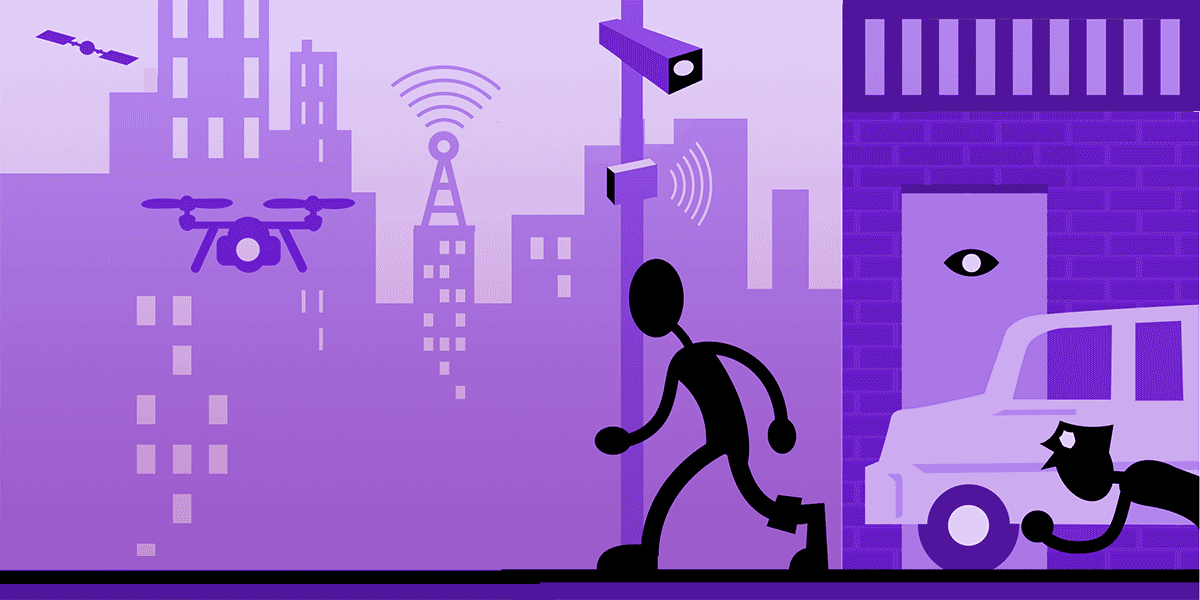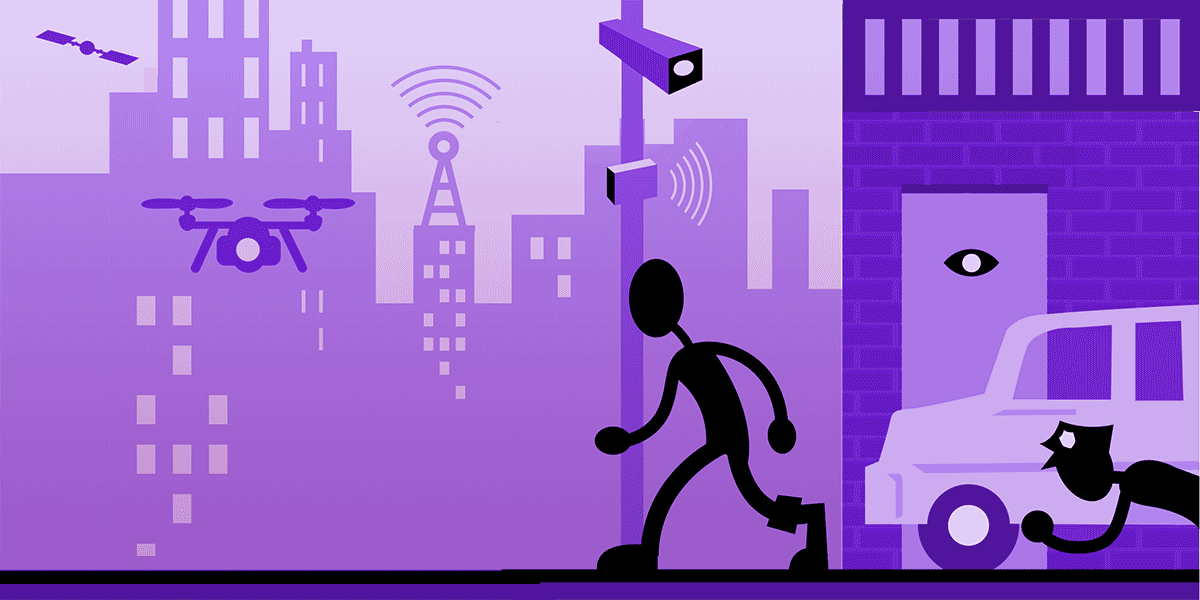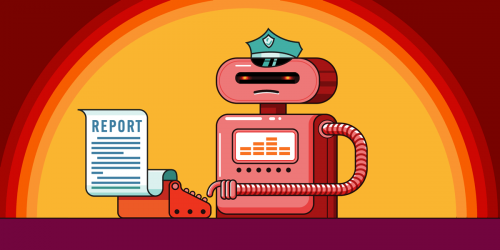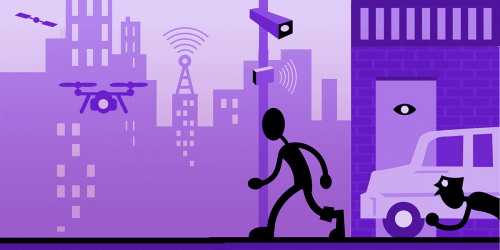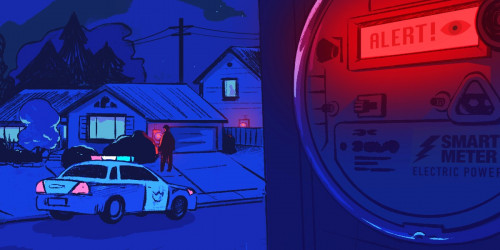When your local police department buys one piece of surveillance equipment, you can easily expect that the company that sold it will try to upsell them on additional tools and upgrades.
At the end of the day, public safety vendors are tech companies, and their representatives are salespeople using all the tricks from the marketing playbook. But these companies aren't just after public money—they also want data.
And each new bit of data that police collect contributes to a pool of information to which the company can attach other services: storage, data processing, cross-referencing tools, inter-agency networking, and AI analysis. The companies may even want the data to train their own AI model. The landscape of the police tech industry is changing, and companies that once specialized in a single technology (such as hardware products like automated license plate readers (ALPRs) or gunshot detection sensors) have developed new capabilities or bought up other tech companies and law enforcement data brokers—all in service of becoming the corporate giant that serves as a one-stop shop for police surveillance needs.
One of the most alarming trends in policing is that companies are regularly pushing police to buy more than they need. Vendors regularly pressure police departments to lock in the price now for a whole bundle of features and tools in the name of “cost savings,” often claiming that the cost à la carte for any of these tools will be higher than the cost of a package, which they warn will also be priced more expensively in the future. Market analysts have touted the benefits of creating “moats” between these surveillance ecosystems and any possible competitors. By making it harder to switch service providers due to integrated features, these companies can lock their cop customers into multi-year subscriptions and long-term dependence.
Think your local police are just getting body-worn cameras (BWCs) to help with public trust or ALPRs to aid their hunt for stolen vehicles? Don’t assume that’s the end of it. If there’s already a relationship between a company and a department, that department is much more likely to get access to a free trial of whatever other device or software that company hopes the department will put on its shopping list.
These vendors also regularly help police departments apply for grants and waivers, and provide other assistance to find funding, so that as soon as there’s money available for a public safety initiative, those funds can make their way directly to their business.
Companies like Axon have been particularly successful at using their relationships and leveraging the ability to combine equipment into receiving “sole source” designations. Typically, government agencies must conduct a bidding process when buying a new product, be it toilet paper, computers, or vehicles. For a company to be designated a sole-source provider, it is supposed to provide a product that no other vendor can provide. If a company can get this designation, it can essentially eliminate any possible competition for particular government contracts. When Axon is under consideration as a vendor for equipment like BWCs, for which there are multiple possible other providers, it’s not uncommon to see a police department arguing for a sole-source procurement for Axon BWCs based on the company’s ability to directly connect their cameras to the Fusus system, another Axon product.
Here are a few of the big players positioning themselves to collect your movements, analyze your actions, and make you—the taxpayer—bear the cost for the whole bundle of privacy invasions.
Axon Enterprise's ‘Suite’
Axon expects to have yet another year of $2 billion-plus in revenue in 2025. The company first got its hooks into police departments through the Taser, the electric stun gun. Axon then plunged into the BWC market amidst Obama-era outrage at police brutality and the flood of grant money flowing from the federal government to local police departments for BWCs, which were widely promoted as a police accountability tool. Axon parlayed its relationships with hundreds of police departments and capture and storage of growing terabytes of police footage into a menu of new technological offerings.
In its annual year-end securities filing, Axon told investors it was "building the public safety operating system of the future” through its suite of “cloud-hosted digital evidence management solutions, productivity and real-time operations software, body cameras, in-car cameras, TASER energy devices, robotic security and training solutions” to cater to agencies in the federal, corrections, justice, and security sectors.”
Axon controls an estimated 85 percent of the police body-worn camera market. Its Evidence.com platform, once a trial add-on for BWC customers, is now also one of the biggest records management systems used by police. Its other tools and services include record management, video storage in the cloud, drones, connected private cameras, analysis tools, virtual reality training, and real-time crime centers.
Axon has been adding AI to its repertoire, and it now features a whole “AI Era” bundle plan. One recent offering is Draft One, which connects to Axon’s body-worn cameras (BWCs) and uses AI to generate police reports based on the audio captured in the BWC footage. While use of the tool may start off as a free trial, Axon sees Draft One as another key product for capturing new customers, despite widespread skepticism of the accuracy of the reports, the inability to determine which reports have been drafted using the system, and the liability they could bring to prosecutions.
In 2024, Axon acquired a company called Fusus, a platform that combines the growing stores of data that police departments collect—notifications from gunshot detection and automated license plate reader (ALPR) systems; footage from BWCs, drones, public cameras, and sometimes private cameras; and dispatch information—to create “real-time crime centers.” The company now claims that Fusus is being used by more than 250 different policing agencies.
Fusus claims to bring the power of the real-time crime center to police departments of all sizes, which includes the ability to help police access and use live footage from both public and private cameras through an add-on service that requires a recurring subscription. It also claims to integrate nicely with surveillance tools from other providers. Recently, it has been cutting ties, most notably with Flock Safety, as it starts to envelop some of the options its frenemies had offered.
In the middle of April, Axon announced that it would begin offering fixed ALPR, a key feature of the Flock Safety catalogue, and an AI Assistant, which has been a core offering of Truleo, another Axon competitor.
Flock Safety's Bundles and FlockOS
Flock Safety is another major police technology company that has expanded its focus from one primary technology to a whole package of equipment and software services.
Flock Safety started with ALPRs. These tools use a camera to read vehicle license plates, collecting the make, model, location, and other details which can be used for what Flock calls “Vehicle Fingerprinting.” The details are stored in a database that sometimes finds a match among a “hot list” provided by police officers, but otherwise just stores and shares data on how, where, and when everyone is driving and parking their vehicles.
Founded in 2017, Flock Safety has been working to expand its camera-based offerings, and it now claims to have a presence in more than 5,000 jurisdictions around the country, including through law enforcement and neighborhood association customers.
Among its tools are now the drone-as-first-responder system, gunshot detection, and a software platform meant to combine all of them. Flock also sells an option for businesses to use ALPRs to "optimize" marketing efforts and for analyzing traffic patterns to segment their patrons. Flock Safety offers the ability to integrate private camera systems as well.
Much of what Flock Safety does now comes together in their FlockOS system, which claims to bring together various surveillance feeds and facilitate real-time “situational awareness.”
Flock is optimistic about its future, recently opening a massive new manufacturing facility in Georgia.
Motorola Solutions' "Ecosystem"
When you think of Motorola, you may think of phones—but there’s a good chance that you missed the moment in 2011 when the phone side of the company, Motorola Mobility, split off from Motorola Solutions, which is now a big player in police surveillance.
On its website, Motorola Solutions claims that departments are better off using a whole list of equipment from the same ecosystem, boasting the tagline, “Technology that’s exponentially more powerful, together.” Motorola describes this as an "ecosystem of safety and security technologies" in its securities filings. In 2024, the company also reported $2 billion in sales, but unlike Axon, its customer base is not exclusively law enforcement and includes private entities like sports stadiums, schools, and hospitals.
Motorola’s technology includes 911 services, radio, BWCs, in-car cameras, ALPRs, drones, face recognition, crime mapping, and software that supposedly unifies it all. Notably, video can also come with artificial intelligence analysis, in some cases allowing law enforcement to search video and track individuals across cameras.
In January 2019, Motorola Solutions acquired Vigilant Solutions, one of the big players in the ALPR market, as part of its takeover of Vaas International Holdings. Now the company (under the subsidiary DRN Data) claims to have billions of scans saved from police departments and private ALPR cameras around the country. Marketing language for its Vehicle Manager system highlights that “data is overwhelming,” because the amount of data being collected is “a lot.” It’s a similar claim made by other companies: Now that you’ve bought so many surveillance tools to collect so much data, you’re finding that it is too much data, so you now need more surveillance tools to organize and make sense of it.
SoundThinking's ‘SafetySmart Platform’
SoundThinking began as ShotSpotter, a so-called gunshot detection tool that uses microphones placed around a city to identify and locate sounds of gunshots. As news reports of the tool’s inaccuracy and criticisms have grown, the company has rebranded as SoundThinking, adding to its offerings ALPRs, case management, and weapons detection. The company is now marketing its SafetySmart platform, which claims to integrate different stores of data and apply AI analytics.
In 2024, SoundThinking laid out its whole scheme in its annual report, referring to it as the "cross-sell" component of their sales strategy.
The "cross-sell" component of our strategy is designed to leverage our established relationships and understanding of the customer environs by introducing other capabilities on the SafetySmart platform that can solve other customer challenges. We are in the early stages of the upsell/cross-sell strategy, but it is promising - particularly around bundled sales such as ShotSpotter + ResourceRouter and CaseBuilder +CrimeTracer. Newport News, VA, Rocky Mount, NC, Reno, NV and others have embraced this strategy and recognized the value of utilizing multiple SafetySmart products to manage the entire life cycle of gun crime…. We will seek to drive more of this sales activity as it not only enhances our system's effectiveness but also deepens our penetration within existing customer relationships and is a proof point that our solutions are essential for creating comprehensive public safety outcomes. Importantly, this strategy also increases the average revenue per customer and makes our customer relationships even stickier.
Many of SoundThinking’s new tools rely on a push toward “data integration” and artificial intelligence. ALPRs can be integrated with ShotSpotter. ShotSpotter can be integrated with the CaseBuilder records management system, and CaseBuilder can be integrated with CrimeTracer. CrimeTracer, once known as COPLINK X, is a platform that SoundThinking describes as a “powerful law enforcement search engine and information platform that enables law enforcement to search data from agencies across the U.S.” EFF tracks this type of tool in the Atlas of Surveillance as a third-party investigative platform: software tools that combine open-source intelligence data, police records, and other data sources, including even those found on the dark web, to generate leads or conduct analyses.
SoundThinking, like a lot of surveillance, can be costly for departments, but the company seems to see the value in fostering its existing police department relationships even if they’re not getting paid right now. In Baton Rouge, budget cuts recently resulted in the elimination of the $400,000 annual contract for ShotSpotter, but the city continues to use it.
"They have agreed to continue that service without accepting any money from us for now, while we look for possible other funding sources. It was a decision that it's extremely expensive and kind of cost-prohibitive to move the sensors to other parts of the city," Baton Rouge Police Department Chief Thomas Morse told a local news outlet, WBRZ.
Beware the Bundle
Government surveillance is big business. The companies that provide surveillance and police data tools know that it’s lucrative to cultivate police departments as loyal customers. They’re jockeying for monopolization of the state surveillance market that they’re helping to build. While they may be marketing public safety in their pitches for products, from ALPRs to records management to investigatory analysis to AI everything, these companies are mostly beholden to their shareholders and bottom lines.
The next time you come across BWCs or another piece of tech on your city council’s agenda or police department’s budget, take a closer look to see what other strings and surveillance tools might be attached. You are not just looking at one line item on the sheet—it’s probably an ongoing subscription to a whole package of equipment designed to challenge your privacy, and no sort of discount makes that a price worth paying.
To learn more about what surveillance tools your local agencies are using, take a look at EFF’s Atlas of Surveillance and our Street-Level Surveillance Hub.


